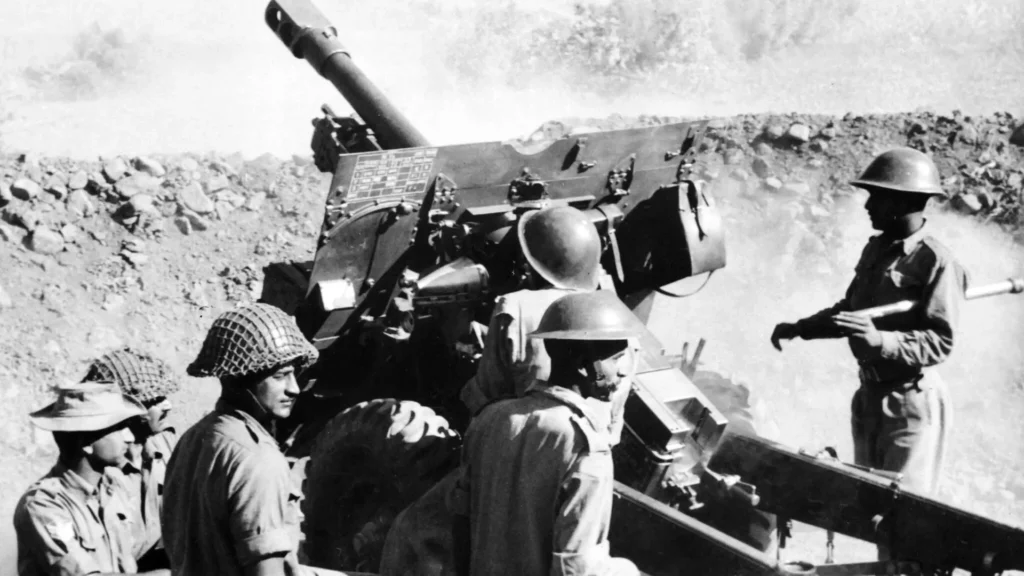1965 Indo-Pak War: From Kutch to Kashmir

Introduction
The partition of British India in 1947 marked the birth of Independent India and Pakistan. However, this newfound independence was overshadowed by conflicts over the land distribution of both nations where Pakistan’s ideologies throughout the time developed with countering India over Jammu and Kashmir (J&K), and on the other hand India raised as a peaceful nation focused on development and safety of self. Over time India witnessed multiple skirmishes that continued and 4 major wars from 1947 to 1999. The 1965 Indo-Pak war was the second war between India and Pakistan where Pakistan’s ultimate goal was to Capture and isolate Jammu and Kashmir (J&K).
Background
During 1965 India witnessed a major war with Pakistan which included armored units from both sides marking it as the largest war fought since WW2 involving tanks. Pakistan was equipped with USA-made weapon platforms whereas India was equipped with a mixture of Soviet, Britain, and US-made World War 2 era weapon platforms.
One major reason lies within Territorial distribution. Both nations claim Jammu and Kashmir (J&K) as their integral part. A full-scale attack was launched on April 24th, 1965 against India. This attack involved four Indian posts Sardar, Vigokot, Point-84, and Chhad Bet in the Rann of Kutch. This operation by Pakistan was named ‘Operation Desert Hawk’.
Operation Desert Hawk

This operation was primarily targeted by Pakistan to test the Indian Armed Forces and the Indian government’s preparedness and response under the leadership of PM Shri Lal Bahadur Shastri. Pakistan’s military under the leadership of overconfident military leader General Ayub Khan, had a strong diplomatic relationship with China and US-made weapon platforms in their arsenal and underestimated India’s power at that time. India in 1962 faced multiple challenges during the Indo-China war which created an image of a weak nation in Pakistan’s leadership mind.
Pakistani soldiers began patrolling in Indian-controlled territory in January 1965, leading to minor clashes between both nations resulting in the deterioration of peace. This further led to a full-scale operation by the Pakistan military involving two armored units also. With sudden attack Pakistani troops were able to penetrate within 6-8 miles of Indian Territory marking the violation of the Indo-Pak Border Agreement 1960 and International Law as per the UN Charter.
After assessing this conflict ‘Operation Gibraltar‘ armed unrest in J&K was launched in August 1965 and ‘Operation Grand Slam’ was a step to completely isolate J&K from India.
Arsenal of 1965
Pakistan was well equipped with US-made weapon platforms as part of military aid giving them an upper hand in quality as compared to India.
- M47 & M48 Patton Tanks: US-made medium tanks, supplied to Pakistan as military air from the US. Both M47 and M48 tanks were superior to Indian tanks and had significant power punch to penetrate enemy armor.
- M4 Sherman Tanks: WW2 veteran US-made tanks under the same military aid to Pakistan played a supporting role, in defence and urban warfare.
- M24 Chaffee: Another US-made light category tank developed during WW2. Primarily designed for head-on assaults. This tank was primarily employed by Pakistan for reconnaissance, flanking maneuvers, and as an additional layer of protection for advancing armored formations.
- M36: Known as a Tank Destroyer made during WW2 and was supplied to many US allies, including Pakistan. This tank held the firepower to penetrate the front armor of Indian Tanks at that time with its 90mm M3 gun.
- 105mm and 155mm Howitzers: These howitzers were also a part of military aid which offered a strong firepower to Pakistan in terms of range and high explosive power that caused significant damage on the battlefield.
India was equipped with a mixture of domestically produced weapons, and older equipment from Britain and the Soviet Union.
- Centurion Tanks: For India, these British-built Centurion tanks were an important element on the Battlefield. India was equipped with the Mk V and Mk VII variants of the Centurion tank. It was used for both defensive and offensive roles during the 1965 war with Pakistan.
- Sherman Tanks: Indian shermans also saw some action during this war. While not equipped with the latest technology, Indian shermans had upgraded guns offering improved firepower.
- PT-76 Light Amphibious Tank: A Soviet-designed light amphibious tank. It was equipped with a 7.62mm cannon sufficient enough to counter enemy light armor.
- Field Gun & Howitzers: Indian artillery during 1965 was not a uniform force and lacked in comparison to Pakistan.
Operation Desert Hawk was limited to ground assault but later the full-scale war declared by Pakistan in August 1965, led to the involvement of Air Forces from both nations, where Pakistan was well equipped with US-made F-86 Sabre jets, B-57 Canberras (bomber), F-104 Starfighters (supersonic air superiority jet). Whereas India was equipped with Hawker Hunters, H-24 Marut, Folland Gnats, Vampire jets, and Mig-21 Fighters (in limited numbers).
Also Read, Triumphs of Valor: India’s Main Weapon Systems in The 1971 War
Conclusion
The 1965 war showcased a fascinating dance between the strengths and strategies of both India and Pakistan. While Pakistan enjoyed a seemingly superior arsenal from US aid, India’s tactical brilliance and adaptability on the battlefield proved to be a formidable counterpoint. With the United Kingdom’s mediation, Pakistan forces withdrew from Indian territory in the Kutch sector. On July 1, 1965, both nations signed the ‘Kutch Agreement’. But this was not the end of the Indo-Pak conflict, Pakistan within 2 months after mutual agreement to the Kutch Agreement, initiated ‘Operation Gibraltar’ and ‘Operation Grand Slam’ in Kashmir. This war serves as a cautionary tale, reminding us that military might isn’t the only factor on the battlefield. It compels us to consider the importance of innovative strategies, leadership, and the ever-present need for peaceful resolution to simmering tensions.





